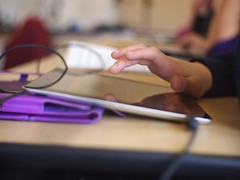
The end of a school quarter is hard. Teacher work piles up and tempers run short. Students face end of term projects and tests. It’s not a great time to push for new, long-term initiative that requires teachers to think outside of their day-to-day concerns. The 1:1 planning workgroup has thus focused on organizing for after the break. Here’s what we’ve learned and accomplished since the last post.
We will reach out to parents, teachers and students in different ways.
Half of the students volunteered to organize branding and outreach. We brainstormed and voted on a name for the initiative, AISB 2.0. To reach parents, we’ve decided to use the existing methods of communication (the newsletter and Facebook page). For teachers, we’ll use the new Teaching and Learning Blog for announcements, which one of our students will write. To reach students we’ve decided to create Twitter and Instagram accounts for announcements and to make a hashtag (tbd). When one of us sees something they like, they’ll take a picture of it and hashtag it, with the goal of showcasing the values we hope to extend with the 1:1 program.
The face-to-face approach is the most effective one you can have.
Coffee morning was a success, and we got ten parents who dropped in to learn about the planning process. They were eager to talk about how technology played a role in their children’s growth and share their aspiration and concerns. We got their contact information so that we can call on them directly for more detailed feedback.
Lunchtime meetings are not useful.
Our 40-minute lunch period was too short to get anything done by the time they got started 10 minutes into the period. We’re switching to one weekly after-school meeting for a more useful block of time. And you know what? Students are willing to show up for something that is not, on its face, “fun.”
Student empowerment is a real thing.
The presentation of a prospective director candidate last got me thinking about the value of student empowerment. In Week 1, I was envisioning having to do much of the publicity and research myself. It turns out that the students from the working group are willing and able to take on the former (see above), and eager to be involved in the latter. Other schools have visited other schools to look at their deployments, and flown in experts to do audits. We probably don’t have the money to any of that. So each student from the AISB 2.0 working group will interview one or two students from a school that is already on a 1:1 program. Half of them already know someone since they attended such a school and still know friends there. For the other half, I’ll reach out to my PLN and ask them to help me connect our students. I’ll still do my due diligence, starting with Google for Education’s Pilot Guide for Bringing Devices to Your School, but my students will bring a broader perspective than I could find on my own.

